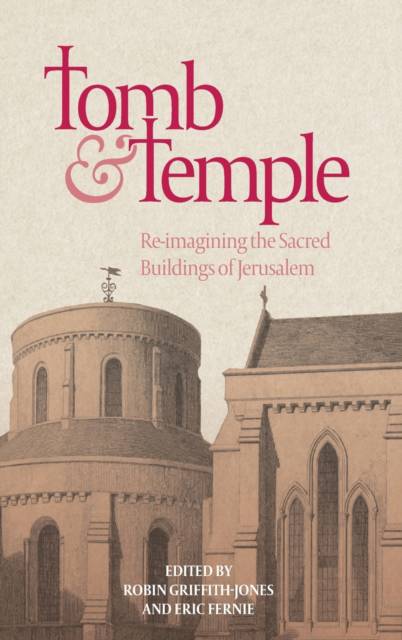
Je cadeautjes zeker op tijd in huis hebben voor de feestdagen? Kom langs in onze winkels en vind het perfecte geschenk!
- Afhalen na 1 uur in een winkel met voorraad
- Gratis thuislevering in België vanaf € 30
- Ruim aanbod met 7 miljoen producten
Je cadeautjes zeker op tijd in huis hebben voor de feestdagen? Kom langs in onze winkels en vind het perfecte geschenk!
- Afhalen na 1 uur in een winkel met voorraad
- Gratis thuislevering in België vanaf € 30
- Ruim aanbod met 7 miljoen producten
Zoeken
Tomb and Temple
Re-Imagining the Sacred Buildings of Jerusalem
€ 298,45
+ 596 punten
Omschrijving
Jerusalem - earthly and heavenly, past, present and future - has always informed the Christian imagination: it is the intersection of the divine and human worlds, of time and eternity. Since the fourth century, it has been the site of the round Church of the Holy Sepulchre, built over the empty tomb acknowledged by Constantine as the tomb of Christ. Nearly four hundred years later, the Sepulchre's rotunda was rivalled by the octagon of the Dome of the Rock. The city itself and these two glorious buildings within it remain, to this day, the focus of pilgrimage and of intense devotion.
Jerusalem and its numinous buildings have been distinctively re-imagined and re-presented in the design, topography, decoration and dedications of some very striking and beautiful churches and cities in Western Europe, Russia, the Caucasus and Ethiopia. Some are famous, others are in the West almost unknown. The essays Inthis richly illustrated book combine to do justice to these evocative buildings' architecture, roles and history.
The volume begins with an introduction to the Sepulchre itself, from its construction under Constantine to theCrusaders' rebuilding which survives to this day. Chapters follow on the Dome of the Rock and on the later depiction and signifcance of the Jewish Temple. The essays then move further afeld, uncovering the links between Jerusalemand Byzantium, the Caucasus, Russia and Ethiopia. Northern Europe comes finally into focus, with chapters on Charlemagne's chapel at Aachen, the role of the military orders in spreading the form of the Sepulchre, a gazetteer of English rounds, and studies of London's New Temple.
ROBIN GRIFFITH-JONES is Master of the Temple at the Temple Church in London and Senior Lecturer (Theology and Religious Studies) at King's College London. He co-edited The Temple Church in London with David Park (2010). ERIC FERNIE is Director Emeritus of The Courtauld Institute of Art, London.
Contributors: Alan Borg, Antony Eastmond, David Ekserdjian, Eric Fernie, Jaroslav Folda, Emmanuel Fritsch, Michael Gervers, Robin Griffith-Jones, Nicole Hamonic, Cecily Hennessy, Robert Hillenbrand, Catherine E. Hundley, Philip J. Lankester, Robin Milner-Gulland, Robert Ousterhout, David W. Phillipson, Denys Pringle, Sebastian Salvadó.
Jerusalem and its numinous buildings have been distinctively re-imagined and re-presented in the design, topography, decoration and dedications of some very striking and beautiful churches and cities in Western Europe, Russia, the Caucasus and Ethiopia. Some are famous, others are in the West almost unknown. The essays Inthis richly illustrated book combine to do justice to these evocative buildings' architecture, roles and history.
The volume begins with an introduction to the Sepulchre itself, from its construction under Constantine to theCrusaders' rebuilding which survives to this day. Chapters follow on the Dome of the Rock and on the later depiction and signifcance of the Jewish Temple. The essays then move further afeld, uncovering the links between Jerusalemand Byzantium, the Caucasus, Russia and Ethiopia. Northern Europe comes finally into focus, with chapters on Charlemagne's chapel at Aachen, the role of the military orders in spreading the form of the Sepulchre, a gazetteer of English rounds, and studies of London's New Temple.
ROBIN GRIFFITH-JONES is Master of the Temple at the Temple Church in London and Senior Lecturer (Theology and Religious Studies) at King's College London. He co-edited The Temple Church in London with David Park (2010). ERIC FERNIE is Director Emeritus of The Courtauld Institute of Art, London.
Contributors: Alan Borg, Antony Eastmond, David Ekserdjian, Eric Fernie, Jaroslav Folda, Emmanuel Fritsch, Michael Gervers, Robin Griffith-Jones, Nicole Hamonic, Cecily Hennessy, Robert Hillenbrand, Catherine E. Hundley, Philip J. Lankester, Robin Milner-Gulland, Robert Ousterhout, David W. Phillipson, Denys Pringle, Sebastian Salvadó.
Specificaties
Betrokkenen
- Uitgeverij:
Inhoud
- Aantal bladzijden:
- 558
- Taal:
- Engels
- Reeks:
- Reeksnummer:
- nr. 13
Eigenschappen
- Productcode (EAN):
- 9781783272808
- Verschijningsdatum:
- 18/05/2018
- Uitvoering:
- Hardcover
- Formaat:
- Genaaid
- Afmetingen:
- 170 mm x 241 mm
- Gewicht:
- 1496 g

Alleen bij Standaard Boekhandel
+ 596 punten op je klantenkaart van Standaard Boekhandel
Beoordelingen
We publiceren alleen reviews die voldoen aan de voorwaarden voor reviews. Bekijk onze voorwaarden voor reviews.








